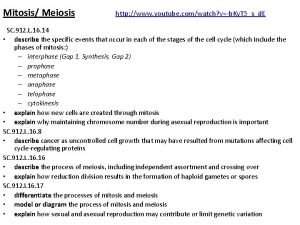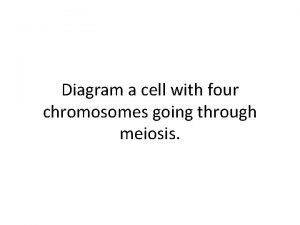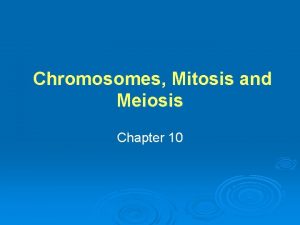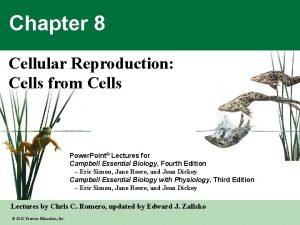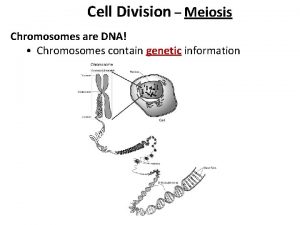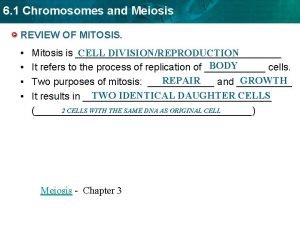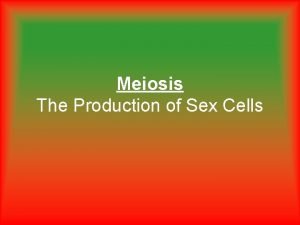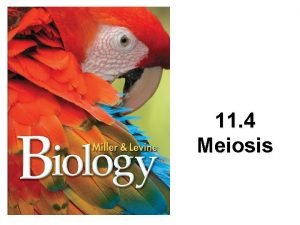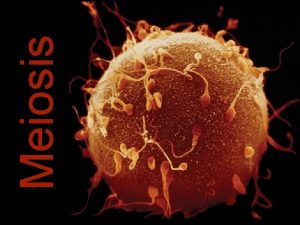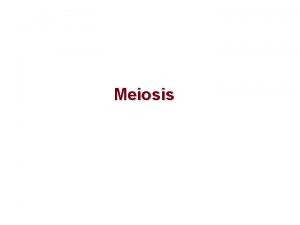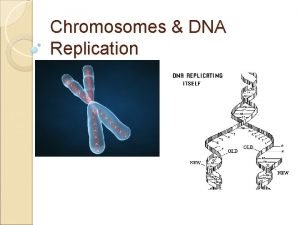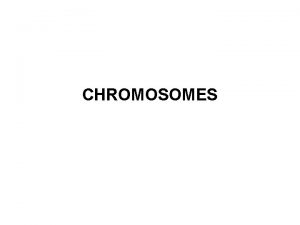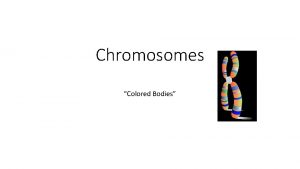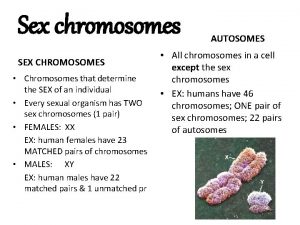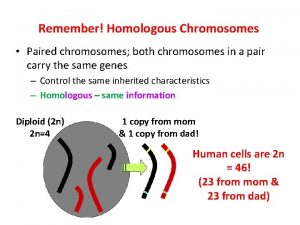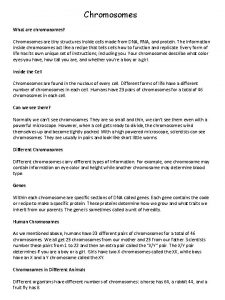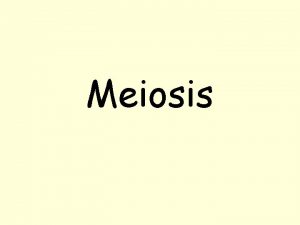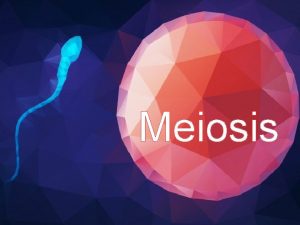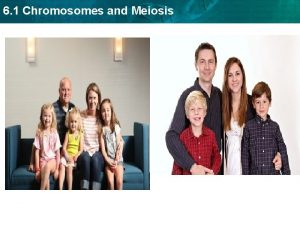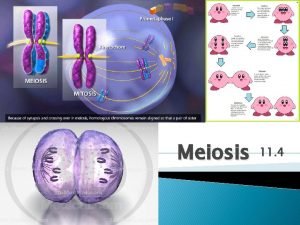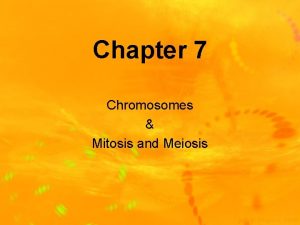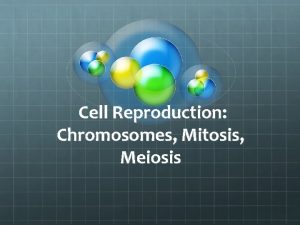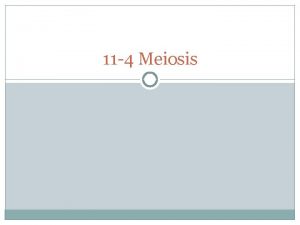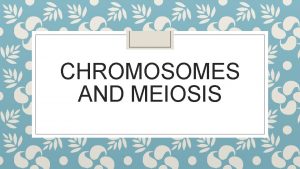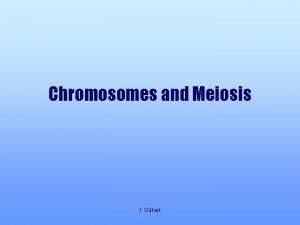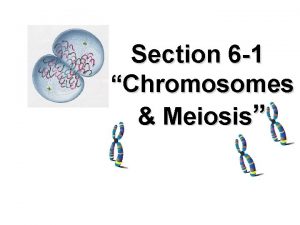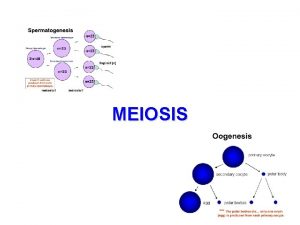MEIOSIS Meiosis Process in which the of chromosomes





























- Slides: 29

MEIOSIS

Meiosis Process in which the # of chromosomes per cell is cut in half by separating homologous chromosomes in a diploid cell.

Homologous Chromosomes that each has a corresponding chromosome from the opposite-sex parent.

Diploid A cell that has both sets of homologous chromosomes. Referred to as 2 N. In a human = 46

Haploid Gametes of sexually reproducing organisms. They have a single set of chromosomes and only a single set of chromosomes. Referred to as N. In a human = 23.

Gamete Sex cell – sperm or egg

Meiosis – overall results Start with 1 diploid cell and end with 4 haploid cells. All 4 sperm cells survive but only 1 out of the 4 eggs survive.

Phases Meiosis I and meiosis II.

Meiosis I ( in humans) Start with 46 chromosomes. They double to 92. They each separate into 2 cells with 46 chromosomes

Meiosis I - stages • Interphase: chromosomes replicate • Prophase I: the replicated chromosome pairs up with its corresponding homologous chromosome. These pairs now form a tetrad.

Crossing over parts of the chromosomes exchange DNA result: new genetic combinations in the cell http: //www. dnaftb. org/11/animation. html

CROSSING OVER (in Meiosis I)

Advantages to sexual reproduction It promotes genetic variability. The offspring, because of crossing over, may have an advantage to handle the changing environment.

Metaphase I and Anaphase I

Telophase I and Cytokinesis 2 cells are now formed

Meiosis II • Start with 2 cells with 46 chromosomes each. • They each divide producing 4 cell which each have 23 chromosomes

Prophase II

Metaphase II and Anaphase II

Telophase II

Cytokinesis II

Gamete formation. Gametogenesis • The end result of meiosis is either: • 4 ovules (eggs) of which only 1 is used in reproduction • 4 spermatids which are all used

Specifics The formation of sperm = spermatogenesis - begins at puberty - sperm are stored in the epididymis The formation of eggs = oogenesis - begins prenatally (before the baby girl is born). - ovules are stored in the ovaries

Gametes to Zygotes After the gametes are fertilized it is called a zygote. The zygote then undergoes mitosis to form an organism.

Mitosis vs. meiosis • Mitosis – results in 2 genetically identical diploid cells • Meiosis – results in 4 genetically different haploid cells https: //www. youtube. com/watch? v=Ba 9 LXKH 2 zt. U

Gene Map Shows exactly where each gene is located on a chromosome

Gene Linkage When genes are located near each other on the same chromosome, they tend to stay together during crossing over. Therefore certain traits appear together in an organism at a higher frequency. Ex: blue eyes and blond hair

Watch AB, ab, CDE, cde

MEIOSIS SQUARE DANCE https: //www. youtube. com/watch? v=XROMXTrklm. Q

NGSS HS-LS 3 -1 HS-LS 3 -2 LS 1. B
 Independent assortment of chromosome
Independent assortment of chromosome Tetrad meiosis
Tetrad meiosis Meiosis diagram
Meiosis diagram Synapsis of homologous chromosomes in meiosis
Synapsis of homologous chromosomes in meiosis Are chromosomes duplicated in interphase or in mitosis
Are chromosomes duplicated in interphase or in mitosis Does meiosis occur in humans
Does meiosis occur in humans Chromosomes number is maintained mitosis or meiosis
Chromosomes number is maintained mitosis or meiosis How many chromosomes in human
How many chromosomes in human Meiosis
Meiosis Miller and levine biology textbook
Miller and levine biology textbook Cell having 6 chromosomes that undergoes meiosis
Cell having 6 chromosomes that undergoes meiosis Phases of meiosis
Phases of meiosis Meiosis and genetic variation answer key
Meiosis and genetic variation answer key What is the difference between mitosis and meiosis 2
What is the difference between mitosis and meiosis 2 Chapter 10 section 1 meiosis
Chapter 10 section 1 meiosis Chapter 10 section 1 meiosis
Chapter 10 section 1 meiosis Where does meiosis occur
Where does meiosis occur Hình ảnh bộ gõ cơ thể búng tay
Hình ảnh bộ gõ cơ thể búng tay Slidetodoc
Slidetodoc Bổ thể
Bổ thể Tỉ lệ cơ thể trẻ em
Tỉ lệ cơ thể trẻ em Voi kéo gỗ như thế nào
Voi kéo gỗ như thế nào Tư thế worm breton
Tư thế worm breton Chúa sống lại
Chúa sống lại Môn thể thao bắt đầu bằng chữ f
Môn thể thao bắt đầu bằng chữ f Thế nào là hệ số cao nhất
Thế nào là hệ số cao nhất Các châu lục và đại dương trên thế giới
Các châu lục và đại dương trên thế giới Công của trọng lực
Công của trọng lực Trời xanh đây là của chúng ta thể thơ
Trời xanh đây là của chúng ta thể thơ Cách giải mật thư tọa độ
Cách giải mật thư tọa độ
